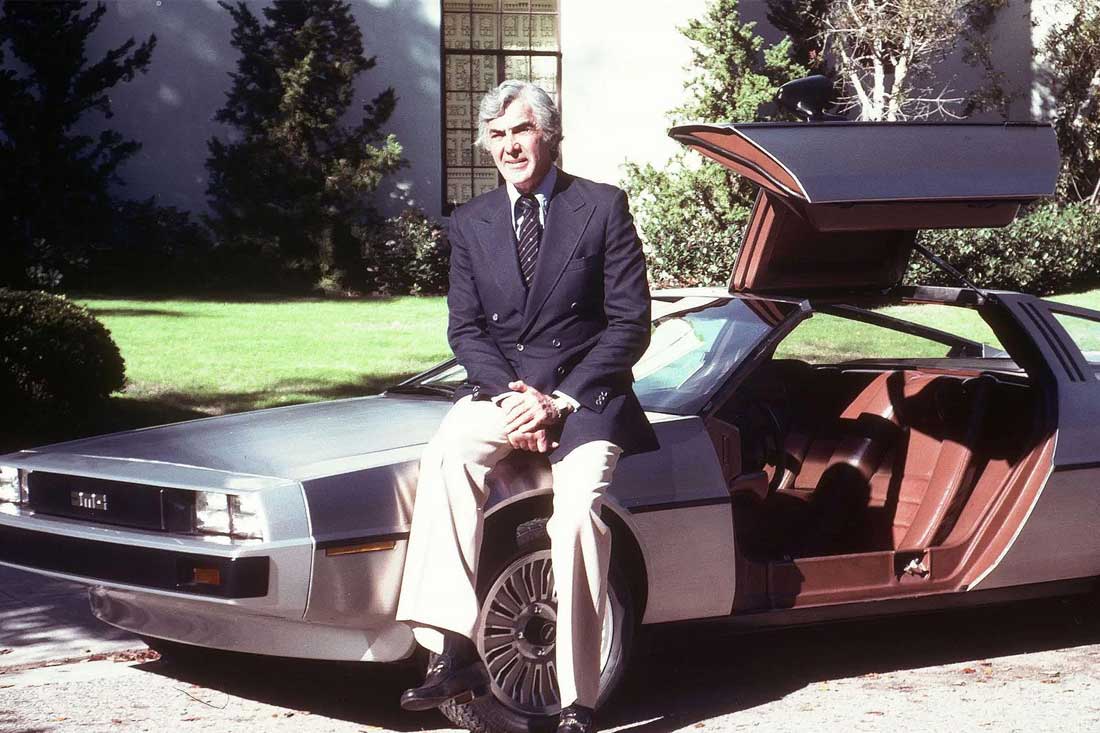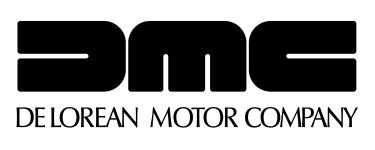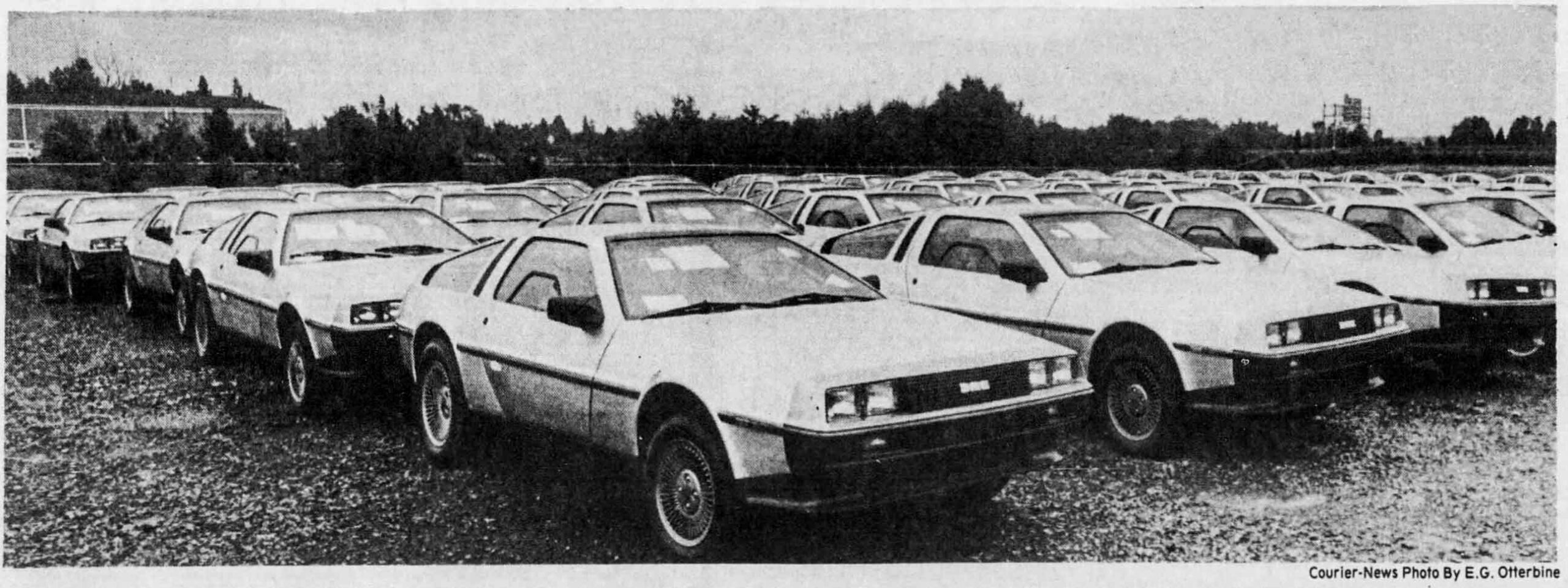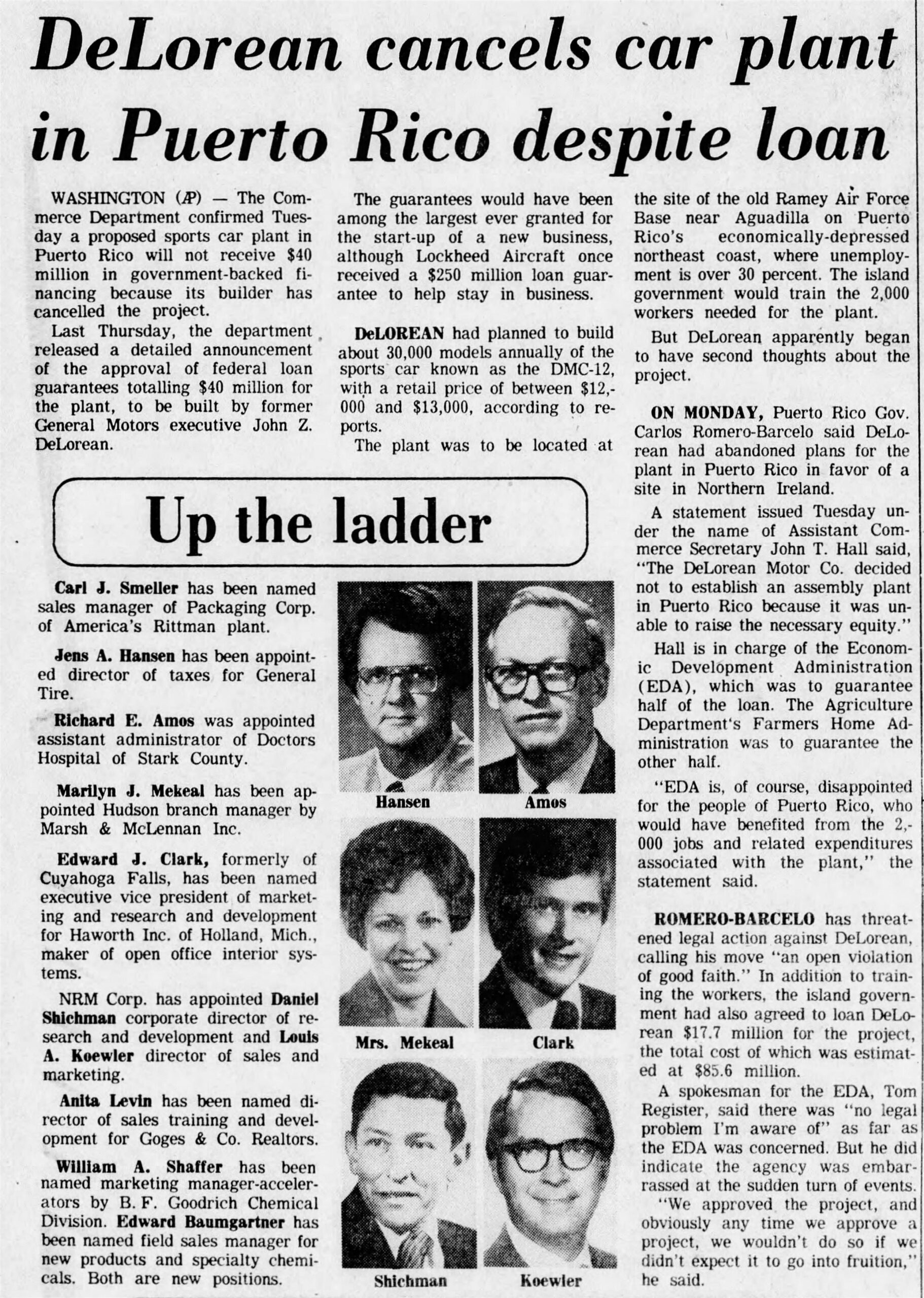DeLorean shop steels itself against time

May 22, 2005 | CHICAGO TRIBUNE | by Steven Kurutz, New York Times News Service
DeLorean feared for kids, polygraph tape indicates

November 10, 1983 | by Linda Deutsch | The Associated Press LOS ANGELES — A videotape of John Z. DeLorean taking a lie-detector test, saying he was “scared silly for my children” during events leading to his arrest on drug trafficking charges, was shown in federal court yesterday. DeLorean, 58, denied on the tape that he ever solicited a drug deal, and he told the polygraph examiner he was forced through threats into negotiating with a government informer posing as a drug dealer. “Of course, my only interest was in staying alive and saving the (DeLorean Motor Car) company if there was any way to do that,” DeLorean told the polygraph examiner just before the test, which defense attorneys arranged. DeLorean told the examiner that he tried to back out of the deal, but that the informer threatened his children and told him, “We’re going to deliver your daughter’s head in a shopping bag.” “I was destroyed by it,” DeLorean said. “I was scared silly for my children.” DeLorean was not in court yesterday for the hearing on the admissibility of polygraph results. The maverick automaker, charged in a $24 million cocaine distribution deal, passed the polygraph test shown on the tape, but a month later flunked a test given by the FBI. Defense lawyers, who plan to seek the dismissal of cocaine conspiracy charges against DeLorean, say they want jurors to see the videotape if the case does go to trial. No trial date has been set. Prosecutors oppose admission of any polygraph results, but say if jurors know of the defense test they also should know of the FBI examination. Earlier yesterday, U.S. District Judge Robert Takasugi ruled that the videotape may be shown on television without damaging DeLorean’s right to a fair trial. In the interview, DeLorean recalled how in 1979 he met James Timothy Hoffman, a neighbor in San Diego, and was contacted by him again in 1982 about a possible investment in DeLorean’s company. DeLorean said he tried to back out of the deal after narcotics were mentioned at a September 1982 meeting, and that Hoffman threatened his children. He spoke of reluctantly going to an Oct. 19, 1982, meeting at a Los Angeles hotel, where he was arrested. “They (undercover government agents) whip out a bottle of champagne and I think I’m toasting the fact that funds are available for the company. They indicate we’re toasting a long series of narcotics transactions. “(A government agent) runs to the closet and jumps out with a suitcase full of bags of cocaine. By now, I’m paralyzed and ready to jump out the window,” DeLorean said on the tape. “I’m convinced if I do anything, I’ll never leave that room alive. And of course, 10 minutes later, they arrest me.”
Receivership Declared at DeLorean

February 20, 1982 | by STEVEN RATTNER, Special to the New York Times www.nytimes.com/1982/02/20/business/receivership-declared-at-delorean.html LONDON, Feb. 19— John Z. DeLorean, the flamboyant American entrepreneur, in a move that amounted to a declaration of bankruptcy, called in receivers today for his Belfast auto maker in a last-ditch effort to keep a slimmed-down version of the company operating. In the face of a weak car market -the $25,000 stainless-steel two-seat sports car is sold exclusively in the United States – and what it viewed as overambitious plans, the British Government, which has already invested $150 million in the project, refused to grant any more aid, ending Mr. DeLorean’s role in car production. Mr. DeLorean, an engineer who had been a rising star in the General American Motors lost $47.2 million in the fourth quarter and $136.6 million in 1981. Page 36. Motors executive suite until he stunned Detroit by quitting his $650,000 job in 1973, had tried to start the world’s first major new auto maker in decades in a strife-torn region of Northern Ireland, where the previous Labor Government had given generous assistance in the hope of providing jobs in an area of 20 percent unemployment and resuscitating the economy. Today’s development threw into doubt the fate of that effort. Not since the Chrysler Corporation was begun in 1920 has a major new American car maker met long-term success. Nevertheless, when he began producing his low-slung, high-performance, safety-oriented car last spring, Mr. DeLorean predicted that the DeLorean would revolutionize the industry. But after an encouraging start, sales slumped badly, and only half the 7,500 cars shipped to America have been sold, even discounted. Nevertheless, Mr. DeLorean said at Claridges Hotel, shortly before departing for New York by Concorde: ”I am delighted at the outcome.” (”We came out largely unscathed,” Mr. DeLorean said in an interview late Friday in New York. ”The Government has the problem, and we have the fun end of the business.” He said that the American parent company, the DeLorean Motor Company, was not affected by the agreement restructuring DeLorean Motor Cars Ltd. Mr. DeLorean, who owns about 80 percent of the shares, said that the American company, which controls the sale and licenses the manufacturing of the cars, would also be relieved of a $70 million obligation to guarantee notes used to build the plant if he put up $5 million, which, he said, he planned to do by next week.) Today, the two receivers, from the firm of W.H. Cork, Gully & Company, estimated that they would have to put together financing of between $75 million and $95 million in the next five weeks, to keep the plant operating. The goal is to sell 8,000 cars a year, instead of the 20,000 envisioned by the 56-year-old Mr. DeLorean. Charges of Mistakes In denying further assistance, James Prior, who as Northern Ireland Secretary effectively governs the troubled province, said bluntly that ”very considerable management and marketing mistakes have been made over the estimate of sales.” ”The time had come when the Government just had to say no,” Mr. Prior, a Conservative, told the House of Commons this morning. ”I do not think there would have been any credibility left in a whole range of matters in which one is seeking to try to help in Northern Ireland if we had taken any other course,” he said. Sir Kenneth Cork, who was joined as receiver by Paul Shewell, said that a number of expressions of interest had been received from businessmen hoping for ”a clean new company not loaded with an overweight debt.” ”There was a dichotomy of management,” Sir Kenneth said. ”I think it was too extravagant a setup for the size of the business.” But he added: ”The receivers believe that there is a market for these motorcars, and it would be a great pity if the skills which have been learned in Belfast were lost.” He said that he would apply to the Government for a short-term working grant. Lien to Government The receivership means that the British Government has effectively written off its investment. However, as the principal creditor, the Government would have a lien on the assets that could be sold or leased to the operating company. Until a rescuer comes forward or the receivers give up, the plant will continue at its current reduced level of output, and the 1,500 remaining jobs will be temporarily preserved. Even before the collapse in sales, Mr. DeLorean had been seeking further British Government aid to develop a second, larger model automobile. The Government had come under considerable pressure not to grant the request because of disclosures that DeLorean Motor Cars Ltd., had just $1 million of private investment, none of it from Mr. DeLorean. In Belfast today, the reaction was almost relief among a work force that had been expecting a complete shutdown. ”It is an encouraging sign at least for the company that Sir Kenneth has given a commitment to maintain it,” said George Clarke, the Transport Workers Union shop steward. —- Statement by DeLorean Mr. DeLorean said in a news conference at the company’s New York headquarters yesterday, that the decision gave the auto maker ”a new foundation” and that it was now ”in significantly better financial shape.” He said he did not intended to sell the company but to get money from American investors to help the company in Belfast. He called ”the continuity of production, sales and service for the DeLorean car” insured.
Central Jersey distribution point for import sports cars

August 13, 1981 | The Courier-News (Bridgewater, New Jersey) | by CARL AYERS; Courier-News Staff Writer Stainless steel autos filling Bridgewater lot The first shipment of the sleek DeLorean sports cars arrived this week in Bridgewater, which will serve as the eastern distribution center for the $25,000 imports. Brought in from Northern Ireland, the cars are lined up on the old Dooley Chevrolet lot at 385 Route 202-206 to be readied for delivery to dealers. There should be 400 on the lot by the end of the week. The unpainted, stainless steel cars, which a spokesman admitted were made with the affluent in mind, are manufactured by John Z. DeLorean, a part-time Bedminster resident. They can hit a maximum speed of 125 mph. DeLorean, a former high-ranking executive at General Motors Corp., shocked the auto industry eight years ago when he left his lucrative job at GM to start his own company. Another surprise came later when he obtained financial backing from the British government to help construct the company’s assembly plant in Belfast. Last April, he and his wife, fashion model Christina Ferrare, bought the 430-acre estate of the Cowperthwaite family for $3.4 million — reportedly the highest price ever paid for a Somerset Hills residence. They live in New York and use the estate’s Lamington House as a weekend and summer vacation home. The automobile lot in Bridgewater, which is being leased from its current owner, is the site of the firm’s Quality Assurance Center for the eastern half of the country. DeLorean could not be reached for comment, but Michael Knepper, a spokesman for the company, said the facility is being used to “make sure everything fits.” The cars get a final cars get a final check before being shipped to dealers east of the Mississippi River. Once the facility is fully staffed, which Knepper said should be within a week, it will take about five days for a shipment of cars to be checked out before being trucked to dealers. He said he did not know how many people would work at the site. “I would hope by the end of next week we’ll have cars being shipped out to dealers,” he said. The center is one of two in the country, he said. The other is located in California and is the distribution point for cars being sent to dealers in the western part of the country. He said that 8,000 of the autos have already been bought by dealers throughout the U.S., who have in turn sold their orders of the highly touted sportscar. “Each dealer has made a minimum investment of $25,000 in equity stock in the company,” Knepper said. The dealers also had to purchase some special tools and spare parts and guarantee to sell between 50 and 150 of the cars within the first two years they are available. The car’s black interior is a mixture of leather and vinyl. The carpet is a light shade of gray and the two bucket seats are genuine leather. Standard equipment includes an AM-FM stereo radio and cassette player, air conditioning, digital clock and electronically controlled windows. It has a standard 5-speed transmission; a 3-speed automatic transmission is available at additional cost. The engine, in the rear, is a V-6 built in France by the consortium of Peugeot-Rennault-Volvo. The company says the fuel-injected engine gets 19 miles per gallon (mpg) in the city and 29.4 mpg on the highway. The automatic transmission engine gets 18 mpg in the city and 24.5 mpg on the highway. There are 14 dealers of the DeLorean cars in New Jersey, including Autosport on Route 22 in Somerville, Knepper said. More than half of the 345 dealers across the nation are GM distributors. The car, the only model produced by the company, has been on sale out West since June. It is now being sold only in this country, and the company is completing arrangements to make the cars available In Canada and Europe, Knepper said. Dealers have received 12,000 orders for the cars from customers who had to deposit between $1,000 and $5,000. Knepper said the company expects to sell 20,000 cars next year. “The only problem we have is building them fast enough.” He said people placing orders for the car might have to wait two months to a year before delivery. Knepper said the car’s “gull-wing doors” — which lift up rather than swing out — are examples of aspects of the auto that attract the people “who buy quality no matter what the price.” Although they are not painted, the cars are “brushed stainless steel,” which gives the autos a silver color. DeLorean left his $650,000 a year job at GM in 1973, citing the company’s growing dissatisfaction with his desire to build smaller and sportier cars. The British government, anxious to aid the economically depressed Belfast area, offered the DeLorean Motor Co. $160 million in grants, loans and equity for the company if its production plant were built in the troubled Northern Ireland city. The 56-year-old DeLorean and Ferrare, 30, have two children, Zachary, 9, and Kathryn, 3. One of the world’s highest paid fashion models, Ferrare was on the March cover of Harper’s Bazaar. She has also been on the cover of other top fashion magazines.
Reprint: DeLorean to peddle car in area
Since leaving General Motors Corp., John De Lorean has been developing the De Lorean DMC-12, a stainless steel sports car that will compete in the market against the Chevrolet Corvette and similar vehicles. Three Twin Cities concerns have signed up to handle the DMC, which is being produced in Ireland and is expected to arrive in U.S. showrooms by the end of the year. The dealers are Carousel Porche-Audi-Renault Inc., Golden Valley; Key Cadillac Inc., Edina; and a partnership formed by Wally McCarthy of Lindahl Oldsmobile Inc. of Minneapolis and Jim Christy of Christy Pontiac-GMC Village, White Bear Lake. McCarthy said about 25 people already have made refundable $5,000 down payments to the partnership for DMCs, which are expected to sell for $16,000 to $20,000 each. The dealership, called WJM & C Corp., with McCarthy as president, will operate out of Christy Pontiac. At Key Cadillac, owner Adam Stanzak said 10 down payments have been received. He added, however, that “at this point (the car) is still a gleam in John De Lorean’s eye.” The Minneapolis Star, Minneapolis, MinnesotaTuesday, March 4, 1980Page 35
DeLorean, Bricklin Spin New Dreams

Thursday, July 29 1979 | BY GLENNA McWHIRTER | Free Press Business Writer | DETROIT FREE PRESS The Paul Newman and the Robert Redford of the auto industry met briefly at the Automotive News World Congress in Dearborn. John Z. DeLorean, who wants to get into the business of building a high-styled, high-performance U.S. sports car, delivered the final speech at the three-day gathering. Malcolm Bricklin, who did what DeLorean hopes to do and went bankrupt, spoke earlier in the day about his latest adventure: helping to develop and market an exotic piston engine called the Bricklin-Turner Power Plant. The charisma index was high, but neither speaker had much solid information to impart. DeLorean refused to answer questions about his DSV sports cars project, saying, as he has for many months, that he is working on the prospectus for the new company and Securities and Exchange Commission rules prohibit prior public announcements. He promised some information would be available in 40 to 60 days. “We are in the final stages of registering for a public (stock) offering and we just can’t talk. It’s killing me,” DeLorean said. Delorean said Bricklin failed in his attempt to start the first new auto company in North America in 30 years because of undercapitalization. BRICKLIN AGREED, and said DeLorean will do better in his attempt because “he’s smarter than I am.” Bricklin and his Canadian-headquartered company spent about $30 million of Bricklin’s — and other people’s money designing, building and marketing about 3.000 Bricklin cars between 1973 and 1975, when the company went bust. Since then Bricklin has moved to Phoenix and has formed a new company called Bricklin Motors Inc. He is chairman. A Phoenix investor and retired Air Force officer, Robert Whitlow, is a primary financial backer and president of the company. He owns the Phoenix Road Runners, a World Hockey Association team. Bricklin’s fiancee (the wedding is set for Sept. 18 in Phoenix) Colleen McCabe is a company director. There are a half dozen other unnamed California and New York investors according to Whitlow, who said: “And we’re looking for about four more.” Bricklin Motors has associated itself with a Graham, Tex., firm called Turner Re-search Inc. This company comprises Frank Turner, an inventor, and some few people of like persuasion. Turner has developed an unusual piston engine with no reciprocating parts. Much of the hardware in a conventional spark ignition has been eliminated. BRICKLIN claims the engine develops high torque, idles at 150 r.p.m., but can rev up to 9,000, is lightweight, compact, smooth running and almost vibration free. Little is known of its capacity to meet emissions standards or of its fuel economy or durability. The engine has never powered a car. So far only prototypes on test stands have been built and a spokesman for Chrysler Corp. said: “As in the case of all current alternative power plants, this one has some potential advantages as well as disadvantages. We just don’t have any data to evaluate.” Bricklin hopes to Interest one or more of the Rig Three auto companies in taking on the cost and effort of pursuing this development work. Brick¬lin and Turner would receive royalties. Turner himself was in town in 1972 trying to interest the automakers in an engine, which he was then calling the Rotary-Vee. Turner and an oil man-auto dealer-entrepreneur named Fred Boaz met unsuccessfully with representatives from all four automakers. Bricklin said he was meeting with Henry Ford II, chairman of Ford Motor Co., late Wednesday to discuss such a project. A Chrysler spokesman confirmed that a similar meeting with unnamed Chrysler executives was scheduled for Thursday. Bricklin planned no meetings with General Motors Corp. or American Motors Corp. John DeLorean and Malcolm Bricklin at auto congress: DeLorean is trying—amid much secrecy—to succeed where Bricklin failed.
DeLorean cancels car plant in Puerto Rico despite loan

August 2, 1978 | The Akron Beacon Journal WASHINGTON (AP) — The Commerce Department confirmed Tuesday a proposed sports car plant in Puerto Rico will not receive $40 million in government-backed financing because its builder has cancelled the project. Last Thursday, the department released a detailed announcement of the approval of federal loan guarantees totalling $40 million for the plant, to be built by former General Motors executive John Z. DeLorean. Up the ladder Carl J. Smeller has been named sales manager of Packaging Corp. of America’s Rittman plant. Jens A. Hansen has been appointed director of taxes for General Tire. Richard E. Amos was appointed assistant administrator of Doctors Hospital of Stark County. Marilyn J. Mekeal has been appointed Hudson branch manager by Marsh & McLennan Inc. Edward J. Clark, formerly of Cuyahoga Falls, has been named executive vice president of marketing and research and development for Haworth Inc. of Holland, Mich., maker of open office interior systems. NRM Corp. has appointed Daniel Shiclunan corporate director of research and development and limas A. Koewler director of sales and marketing. Anita Levin has been named director of sales training and development for Goges & Co. Realtors. William A. Shaffer has been named marketing manager-accelerators by B. F. Goodrich Chemical Division. Edward Baumgartner has been named field sales manager for new products and specialty chemicals. Both are new positions. The guarantees would have been among the largest ever granted for the start-up of a new business, although Lockheed Aircraft once received a $250 million loan guarantee to help stay in business. DeLorean had planned to build about 30,000 models annually of the sports car known as the DMC-12, with a retail price of between $12,000 and $13,000, according to reports. The plant was to be located at the site of the old Ramey Air Force Base near Aguadilla on Puerto Rico’s economically-depressed northeast coast, where unemployment is over 30 percent. The island government would train the 2,000 workers needed for the plant. But DeLorean apparently began to have second thoughts about the project. ON MONDAY, Puerto Rico Gov. Carlos Romero-Barcelo said DeLorean had abandoned plans for the plant in Puerto Rico in favor of a site in Northern Ireland. A statement issued Tuesday under the name of Assistant Commerce Secretary John T. Hall said, “The DeLorean Motor Co. decided not to establish an assembly plant in Puerto Rico because it was unable to raise the necessary equity.” Hall is in charge of the Economic Development Administration (EDA), which was to guarantee half of the loan. The Agriculture Department’s Farmers Home Administration was to guarantee the other half. “EDA is, of course, disappointed for the people of Puerto Rico, who would have benefited from the 2,000 jobs and related expenditures associated with the plant,” the statement said. ROMERO-BARCELO has threatened legal action against DeLorean, calling his move “an open violation of good faith.” In addition to training the workers, the island government had also agreed to loan DeLorean $17.7 million for the project, the total cost of which was estimated at $85.6 million. A spokesman for the EDA, Tom Register, said there was “no legal problem I’m aware of” as far as the EDA was concerned. But he did indicate the agency was embarrassed at the sudden turn of events. “We approved the project, and obviously any time we approve a project, we wouldn’t do so if we didn’t expect it to go into fruition,” he said.


